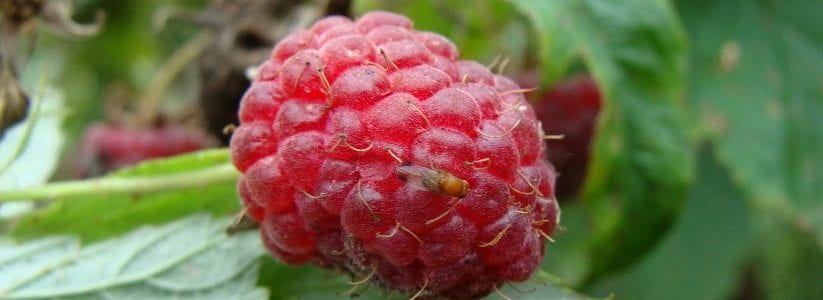Raspberries are just about the most susceptible fruit crop grown in New York State. It’s time to learn how to protect this crop! Fruit that is ripening and ripe is at risk of infestation. SWD has been caught at all but one of the monitoring locations across the State and raspberry harvests are underway.

This year summer raspberry (floricane types) won’t escape infestation simply because their fruiting season is earlier than fall raspberry (primocane types). Both types of raspberries will be highly vulnerable.
An insecticide program is an essential component of managing SWD in fall raspberries; this year it will be in summer raspberries, as well. Things to consider regarding insecticide programs for SWD, with specific emphasis on materials registered for raspberries:
- Population growth models for SWD calculate, theoretically, that using the most efficacious insecticide first will more successfully lower SWD numbers by knocking the population back to close to zero and delaying population growth. (This is strikingly similar to classic principles of plant disease epidemiology and tactics in plant disease management.)
- Rotate use among insecticides with different IRAC groups — related to the mode of action of the insecticide — to reduce selection pressure for insecticide-resistant populations of SWD.
- Insecticides with probable excellent efficacy include – Delegate WG (1 day), Bifenture 10DF (3 days), Brigade WSB 2(ee) (3 days), Brigade EC 2(ee) (3 days), Danitol 2.4EC (3 days), and Mustang Maxx (1 day). Of these, choose first the one with the longest pre-harvest interval (given in parentheses) that you can accommodate; some may be out of the question at this point. Rotate to other insecticides with shorter pre-harvest intervals for closer to harvest.
- After using a highly efficacious insecticide, for the subsequent application, it is usually adequate to use an insecticide that has lower efficacy – Entrust Naturalyte 2(ee) (1 day), Entrust SC 2(ee) (1 day), Assail 30SG 2(ee) (1 day), Malathion 5EC 2(ee) (1 day), Malathion 8 Aquamul 2(ee) (1 day), Malathion 57 2(ee) (1 day), or Molt-X (0 days).
- For organic production, Entrust 2(ee) (1 day) (Naturalyte and SC formulations) is the most efficacious organically-approved insecticide. Rotate this material with either Pyganic (0 days), AzaSol (0 days), Grandevo (0 days), or Venerate (0 days).
- The spray interval column in the Insecticide Quick Reference Guide table relates to use of the same product back-to-back. When switching to another mode of action, weekly applications are OK and are suggested against SWD.
- Research on berries has shown Mustang Maxx isn’t very rain fast, so plan to re-cover if significant rain occurs during the spray interval.
- Don’t stretch intervals between sprays more than about seven days.
- Get excellent coverage. Spray every row (no alternate row spraying.)
Review the Quick Reference Guide to SWD Insecticides for berries at www.hort.cornell.edu/fruit/pdfs/swd/berry-insecticides.pdf
Other tactics that can help considerably are:

Re-set raspberry and blackberry fields: Because raspberry and blackberry continue to flower and set fruit over a protracted period of time, it is possible and advisable to “re-set” the field. When fruit infestation is found via salt flotation or high numbers of SWD are caught in traps in the field, clean pick all ripe and cull fruit. Remove this fruit from the planting and solarize it or freeze it to kill SWD. Solarize in sealed, clear plastic bags set in the sun. After clean picking, spray insecticide. Choose a material with excellent efficacy against SWD and an appropriate days-to-harvest interval.
Sanitation: Pick off and remove all cull fruit from the planting. Routine sanitation can be very beneficial in IPM — it eliminates SWD food and egg-laying resources and slows population growth. And when done routinely, it takes a lot less time and is a lot more effective. Cull fruit can be placed in clear plastic bags and left in the sun to bake or placed in a freezer to kill SWD larvae.
Mowing: Keeps the environment in the plant’s microclimate hot, sunny, and dry. On diversified farms, do be careful when timing mowing or renovation of strawberry fields so as to reduce movement of SWD from that crop into the next ripening crop on your farm. See last year’s blog, Renovate strawberry plantings promptly, blogs.cornell.edu/swd1/2018/06/27/renovate-strawberry-plantings-promptly/.
Weed management: Keeps the environment in the plant’s microclimate hot, sunny and dry, and provides no alternate hosts.
Pruning: Keeps the environment in the plant’s microclimate hot, sunny and dry, and improves spray penetration and deposition. Find out details about how this can be done in raspberry on this blog, Pruning caneberries to minimize SWD habitat within the planting, blogs.cornell.edu/swd1/2017/06/27/pruning-caneberries-to-minimize-swd-habitat-within-the-planting/
Cold storage: Put harvested fruit into a cooler at 32-34 F as soon as possible after harvest. Hold it there to slow and kill SWD larvae and eggs. Raspberries can tolerate 32 F storage conditions.
Consult Cornell Fruit Resources SWD Management, fruit.cornell.edu/spottedwing/management/.
Monitoring tips for SWD
Salt flotation: Routinely sample a subset of fruit that’s being harvested using salt flotation to alert you to the presence of larvae in fruit. A simple method for this is in Guidelines for Checking Fruit for SWD Larvae in the Field by Laura McDermott, available on Cornell Fruit Resources SWD pages at cpb-us-e1.wpmucdn.com/blogs.cornell.edu/dist/0/7265/files/2017/01/SaltFloatation-2kmt284.pdf.

Two growers describe their success using salt flotation to monitor infestations in blueberries, detailed on the blog, Use salt flotation to check for SWD, blogs.cornell.edu/swd1/2018/09/11/use-salt-flotation-to-check-for-swd/
Traps: It is relatively easy to use red or yellow sticky cards to monitor for distinctive male SWD's in fruit plantings. Set the sticky card traps on the edge of the planting where it is convenient to read them daily. Use a coffee stirrer to scrape off and discard the stuck insects daily and replace the sticky card when its stickiness has worn off. Here’s one place you can order trap and lure supplies – Great Lakes IPM, www.greatlakesipm.com/.
SWD populations will build rapidly when fruit is available for oviposition sites, during warm, humid, cloudy weather, and wherever crop canopies are dense and weeds are not managed or mowed. A mated female can lay about 1-3 (or more) eggs per fruit, 7-16 eggs per day, and about 350 eggs during her life span of about three weeks.
So stay informed!
Comprehensive information on SWD IPM is available in Spotted Wing Drosophila IPM in Raspberries & Blackberries from the NE IPM Center SWD Working Group, neipmc.org/go/swdpub1
Consult Cornell Fruit Resources SWD Management, fruit.cornell.edu/spottedwing/management/.
Refer to the Cornell Pest Management Guidelines, cropandpestguides.cce.cornell.edu/ and always have the latest version -- the 2019 version for Berry Crops.
For organic growers, Management Recommendations for Spotted Wing Drosophila in Organic Berry Crops, www.canr.msu.edu/ipm/uploads/files/SWD/SWDOrganicBerryCrops.PDF
SWD prefers nice ripe fruit — like we do! Let’s keep our fruit to ourselves!

